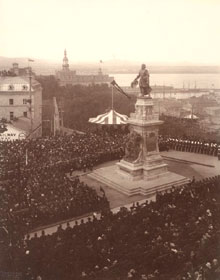History is what we make it
Ronald Rudin finds messages in our views of icons

The monument to Samuel de Champlain, unveiled in Quebec City in 1898.
Photo courtesy of the Musée de la Civilisation de Québec, Fonds d’archives du Séminaire de Québec.
Public celebrations like memorials and commemorations can be at least as influential in shaping people’s perceptions of past events as books and articles written by professional historians, says Ronald Rudin, chair of Concordia’s History Department.
Moreover, historical figures and events have long been used on such public occasions to reinforce contemporary messages — a tendency that is still evident today in preparations for next year’s celebrations of the 400th anniversary of the beginning of European settlement in Canada.
Rudin, who has received a grant to examine the preparations for next year’s events, has recently analyzed historical views of two important figures in the history of Quebec. Samuel de Champlain, the French explorer who founded Quebec City in 1608, and Monseigneur François de Laval, the first bishop of Quebec, were celebrated with big events about a century ago.
In his new book, Founding Fathers: The Celebration of Champlain and Laval in the Streets of Quebec, 1878-1908, Rudin describes four large public spectacles to commemorate these men in the late 19th and early 20th centuries, looking in particular at the aims of the organizers.
“Both [Champlain and Laval] were celebrated, but they were celebrated by different people with different agendas,” Rudin explained. He added that these celebrations had enormous potential to shape people’s views of the past, and were attended by tens or even hundreds of thousands of people in Quebec City.
Laval, often seen as the religious father of French Canada, was remembered in 1877 after his bones were rediscovered, while a monument to Champlain was unveiled in 1898. The celebrations of both figures culminated in 1908, the 200th anniversary of Laval’s death and the 300th anniversary of the founding of Quebec by Champlain.
The organizers of these large commemorative events, which included processions, re-enactments and dedications, were to some extent competing for the hearts and minds of French Canadians within the context of contemporary issues, Rudin explained.
“Both the people who were celebrating Laval and the people who were celebrating Champlain had early-20th-century messages,” he said. “The ideologies were certainly in competition with each other.”
Champlain, a secular figure, was portrayed as a founder of Canada, a country where the French and the English got along and lived happily under the umbrella of the British Empire. This was a remarkable twist, considering Champlain had sailed in the service of France and died more than a century before the English conquered New France.
This view of Champlain was influenced by the need to shore up French-Canadian support for the British Empire as the threat of war loomed. “What they wanted to do in this celebration was to make French-Canadians feel good about a history where French and English were getting along,” Rudin said.
By contrast, Laval, the first bishop in all of North America, was presented as a Catholic hero at a time when Catholicism played a central role in French-Canadian society. The implicit message of the events around him was that “the empire that French-Canadians might be loyal to was the Catholic empire.”
Although for many people, there was nothing contradictory about being a good Catholic and supporting the British Empire, “there was an issue in the early 20th century as to whether Canadians were prepared to support military activities overseas in support of the British Empire,” Rudin said.
Like professional historians, organizers of commemorative events always reflect their own time, Rudin elaborated. “Whoever is involved in presenting the past to whatever public is involved in an exercise in editing, and is going to choose, for better or for worse, what it is they want to present.”
Indeed, “there is presumably some message that they want either the reader or the observer at a spectacle to come away with, because otherwise, why would you write the book or why would you stage the spectacle?”
The same is true for next year’s celebrations of the 400th anniversary of the beginning of European settlement in Canada. Rudin is following the preparations for these events, which gives him an opportunity to do what he could not in his previous research: talk to organizers, participants and spectators. He will examine to what extent the lessons learned by visitors match the aims of the organizers.
One of the celebrations sponsored by the federal government will actually be held in France next year, with the aim of reinforcing trade ties between the two countries.
Tens of thousands of people are expected to attend the celebrations, Rudin said.
“It would suggest that it’s still the case that if you have a message to communicate about the past and you communicate it effectively, you can still attract large numbers of people who presumably are interested in learning something about the past.”